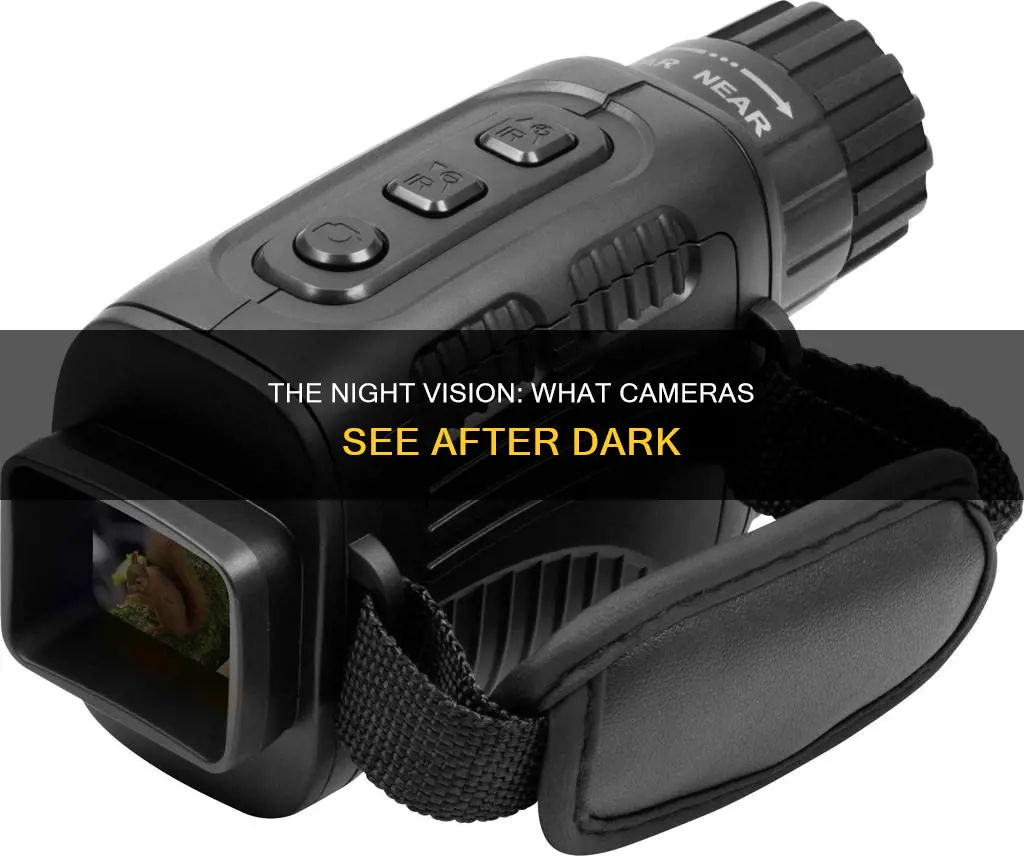
Night vision cameras are a popular security measure, used by businesses and individuals alike. They are also used by police officers, security guards, rescuers, hunters, and fishermen. These cameras are able to monitor and record video under any light conditions, and can capture clear images even in poor lighting. This is made possible by night vision technologies such as infrared, thermal imaging, and low-light night vision. Infrared technology, for example, uses infrared light to illuminate an area that the human eye cannot perceive, while remaining invisible to the naked eye. This allows the camera to capture clear images at night, without giving away its position.
| Characteristics | Values |
|---|---|
| Range | 100-200 ft |
| Lighting conditions | Artificial light improves visibility |
| Technology | Infrared, EXIR, thermal, CCD, low-light night vision |
| Image | Black and white or colour |
| Focal length | Variable or fixed |
| Resolution | 720p, 1080p, 4MP, 5MP, 8MP (4K) |
| Aperture | Larger aperture allows more light in |
| Image sensors | Larger sensors gather more light |
| Placement | Height and angle affect range of view |
What You'll Learn

Infrared night vision
Infrared night-vision cameras use image sensors to capture the reflected infrared light and produce an image. The image sensor is usually a charge-coupled device (CCD) sensor, which is also used in digital cameras and camcorders. The sensor converts the incoming light into an electrical signal, which is then processed to create a visible image.
Mastering Camera IQ: A Guide to Understanding Your Camera's Settings
You may want to see also

Thermal night vision
Advantages of Thermal Night Vision
The primary advantage of thermal night vision is its ability to function in total darkness and challenging conditions. It does not rely on visible light, making it highly effective in low-light environments. Additionally, thermal night vision can see through obscurants, ensuring clear visibility even in smoky or foggy conditions. This capability sets it apart from traditional night vision technologies.
Another benefit of thermal night vision is its ability to detect hidden objects or individuals. This feature is invaluable for security purposes, as it enables the detection of intruders or concealed items. In wildlife observation, thermal imaging highlights camouflaged creatures, providing a distinct advantage for hunters or nature enthusiasts.
Applications of Thermal Night Vision
Performance and Features
In conclusion, thermal night vision offers unparalleled advantages for various applications. Its ability to see in complete darkness and detect heat signatures makes it a powerful tool for security, hunting, and surveillance purposes. With continuous advancements in technology, thermal night vision is becoming increasingly accessible and indispensable in numerous fields.
What My Camera Sees: True Reflection?
You may want to see also

EXIR night vision
EXIR, or Extended Infrared, is an advanced infrared technology used in security cameras to enhance night vision quality. Unlike traditional IR, EXIR provides more efficient and evenly distributed illumination, improving image clarity in low-light conditions.
EXIR technology addresses the issue of brightness in the centre of images captured by conventional cameras, which is achieved by focusing on lens patterns. EXIR, on the other hand, creates a rectangular pattern with even light distribution, ensuring that objects are evenly illuminated and that there is light on the edges of the frame. This technology also reduces overexposure in the centre of the image, resulting in clearer and sharper images.
EXIR 2.0, an improved version of the technology, eliminates the need for an additional lens, as it features a built-in optical lens for proper illumination. This advancement also reduces optical loss, improves heat dissipation, and extends the lifespan of the IR LEDs, making it a more durable and effective solution for night-time surveillance.
EXIR technology optimises security camera performance by enhancing infrared illumination, reducing overexposure, and improving edge clarity for sharper images in low-light environments. This makes it an ideal solution for monitoring dark areas and enhancing visibility in any dark environment.
Mobile Camera Viewing: Easy Access for All
You may want to see also

Low-light night vision
The SIONYX Nightwave Marine Night Vision Camera, for example, is an ultra-low-light camera that enables mariners to navigate safely and avoid collisions at night. With a sensitive CMOS sensor, it can detect obstacles and debris in moonless starlight, providing clear colour digital night vision. This camera is also rugged and built to withstand tough marine environments, with protection against water, sand, salt, and dust.
Another example is the Black Oak LED Nitron XD Night Vision Camera, which provides crystal-clear imagery in complete darkness. This camera excels in low-light conditions, offering the highest resolution possible at any time of day. It is particularly useful for early morning navigation when the water temperature is the same as floating objects, which would render a thermal camera useless.
When choosing a low-light night vision camera, consider factors such as resolution, lens aperture, and sensor size. A larger sensor will gather more light, resulting in brighter and clearer images. Additionally, ensure that the camera is placed in an optimal location, avoiding direct and strong light that may blind the lens.
Apple Watch 5: Camera Location and Functionality
You may want to see also

CCD night vision
CCD technology is used in night vision cameras, which rely on infrared light to see clearly at night. This technology illuminates areas with visible light that is imperceptible to the human eye. This method allows high-quality night vision cameras to see between 100 and 200 feet away, providing 24/7 monitoring capabilities.
Infrared (IR) LEDs are a crucial component of CCD night vision cameras, emitting light that is invisible to the human eye but easily detectable by camera sensors. This enables cameras to capture clear images even in low-light conditions. The number and strength of these LEDs influence the quality of night vision, with more and stronger LEDs resulting in superior image clarity.
EXIR (Extended Infrared) technology represents an advanced form of infrared used in some CCD night vision cameras. It enhances night vision by providing more uniform illumination and reducing overexposure in the centre of the image, leading to sharper visuals. EXIR also prolongs the lifespan of IR LEDs, making it a durable option for night-time surveillance.
Using OBS to See Your Camera: A Quick Guide
You may want to see also
Frequently asked questions
NV cameras collect and enhance the intensity of available light, while IR-illuminated models capture infrared radiation emitted by objects that radiate heat. NV cameras are ideal for cloudless nights and places without light, while IR devices are used in dark conditions.
Night vision is the ability of cameras to monitor and record video under any light conditions. This is achieved through infrared technology, thermal imaging, or low-light night vision.
On average, night vision cameras can see between 100 and 200 feet. However, the exact range depends on various factors, such as lighting conditions, lens aperture, and camera resolution.







